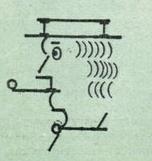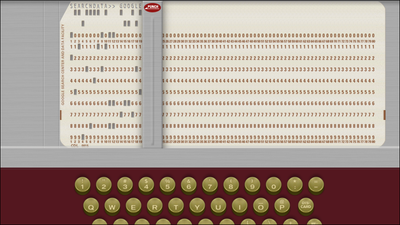Why is the character array of the keyboard "QWERTY"?

BySarah
Speaking of basic keyboard layoutQWERTY arrayBut, when you touch the keyboard for the first time, there are many people who have wondered "Why is this such a strange arrangement?" Where the origin isHackadayI am exploring.
The Origin of QWERTY | Hackaday
http://hackaday.com/2016/03/15/the-origin-of-qwerty/
◆ Birth of the keyboard parent "typewriter"
The creation of the keyboard arrangementTypewriterI am from. This typewriter is not invented by a single human being, but it is thought that many people have advanced to the present shape while making many inventions and improvements. Henry Mill in the UK is known as the earliest inventor of such typewriters. In 1714 he got a typewriter patent as "convenient for writing and transcribing letters cleanly and precisely one by one, writing mediation and official documents". There is almost no information left on this device, but it seems that this was not a process of transferring characters with ink. However, at the time Mill's typewriter was developed, it was also used as a typewriter instead of inkCarbon paperWas not invented.
The first time a typewriter using carbon paper was mentioned was the American science magazine in June, 1867Scientific · AmericanIt was invented by John Platt that was published in. This type typewriter said that when a dial was pushed, the hammer got off and was able to push the letters one character at a time on the paper. The typewriter invented by Pratt seems to have been arranged with clean letters vertically and horizontally, unlike what the current keyboards are arranged with the keys shifted little by little.
A description on typewriters published in Scientific American. The typewriter invented by Pratt is what is called "pet lo type" and it seems that the number of keys was 17 pieces.

Rasmus Maring Hansen of Denmark developed the first typewriter with one key per character. The typewriter he invented in 1865 is called "Maring Hansen · Lighting Ball". This typewriter had a dome shape, and it had a strange look that the key for input was extending from there. When this key is pushed, hammer gets down inside so that letters can be printed on paper.
However, "Milling Hansen Lighting Ball" could not check the letters while typing, and the arrangement of the keys was not random. Arrangement of letters is to place frequently used under the finger that can press the fastest, and it seems that other key placement was determined by learning it.
The actual thing of Mling Hansen · writing ball is such looks.

It is said that Mling Hansen · Lighting Ball was "the first typewriter that can print letters faster than handwriting".
◆ Sholes typewriter
And the first commercially successful typewriter in the world was developedChristopher Latham ShoalsIt is.
The Shawls were invented in 1846Printed telegraphWe designed a typewriter based on. Piano style keyboards are adopted for printed telegraph, and alphabets are carved on each keyboard to indicate which character keyboard.
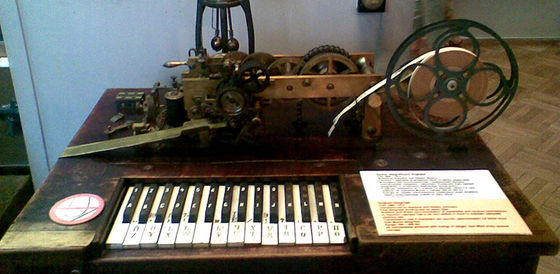
Therefore, even with typewriters developed first by Shoes, the print telecommunication keyboard was adopted. This typewriter gets patent (7868), but it did not succeed commercially.
The key arrangement of typewriters developed first by Shoals.

The typewriter developed in 1870 by Scholes who gave up the key placement of piano style has placed the key of capital alphabet, 2 to 9 numbers, hyphen, comma, period, question mark, at first glance, modern keyboard It is a key arrangement that is very similar to. Basically these key arrangements are in alphabetical order, but the feature is that vowels are placed at the top of the string.

Although Scholes seems to have tried to get out of typewriter business right away, George Harrington and Daniel H. Craig's American Telegraph Works will talk about wanting to purchase Shoulder typewriters. However, as typewriter was not manufactured at that time, some changes will be made to the key placement.
◆ The beginning of QWERTY
From here the key of the QWERTY array is born. The QWERTY array was designed for Morse code, and the keyboardhome positionIt is said to arrange frequently used characters in. However, in the 19th century America where the QWERTY sequence was born, the Morse code was used differently than the current Morse code.
At that time the American Morse code was slightly different from the current international standard, "Y" was "... ... (TONTON, SPACE, TONTON)", "Z" "... · (Tong Tong Tong, Ton) ", and it seems that" Z "was confused with" SE "if it is the first letter. From here, in the QWERTY arrangement, "Z", "S" and "E" are to be placed nearby. "C" represented by "· · · (tenton, space, ton)" is also placed close to "S" and "E" which is easily confused. In addition, American-style Morse code is no longer used because it is easy to confuse some characters.
A key typewriter with these improvements will be posted on Scientific American on August 10, 1872. The key arrangement is as follows and you can see that the letters "QWE.TY" are lined up in a horizontal row and are very close to the current key arrangement. However, "M" is not next to "N", and "C" and "X" are different from the current QWERTY sequence. As this is the first commercially successful typewriter, it will be the basis of key arrangement.
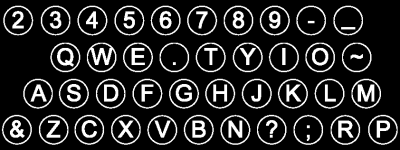
After that, Shawls and other developers were known at the time in sewing machine manufacturingRemington ArmsContact the manufacturer to manufacture a typewriter. Remington signed a contract and in 1873 it will manufacture "Sholes & Glidden Type-Writer", the first typewriter for the company. At this time, Scholes will sell typewriter patents to Densmore and Yost for $ 12,000.
In this "Sholes & Glidden Type-Writer", the letters "O" and "I" are arranged near the key "9", and "Y" comes next to "T" as requested by Scholes So the placement was changed. In 1878, Byron Alden Brooks invented the "platen shift mechanism". This is a mechanism that makes it possible to input two kinds of characters with one key, Remington releases a typewriter that adopted this in 1882.
In this typewriter the placement of "2" changed dramatically, "M" came next to "N".
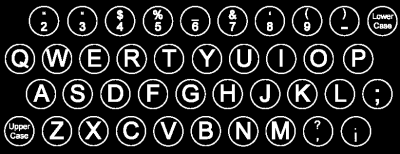
That is, the QWERTY array is not designed to prevent jamming (arm tangling) by typewriters, it is not an array created for the brand name "QWERTY", but it is the initial typewriter user's Morse code It was designed for the operators. In addition, when the stenographer of the time used a typewriter, it seems that there was also a fierce person who can record more than 100 words in one minute.
Related Posts:
in Note, Posted by logu_ii


